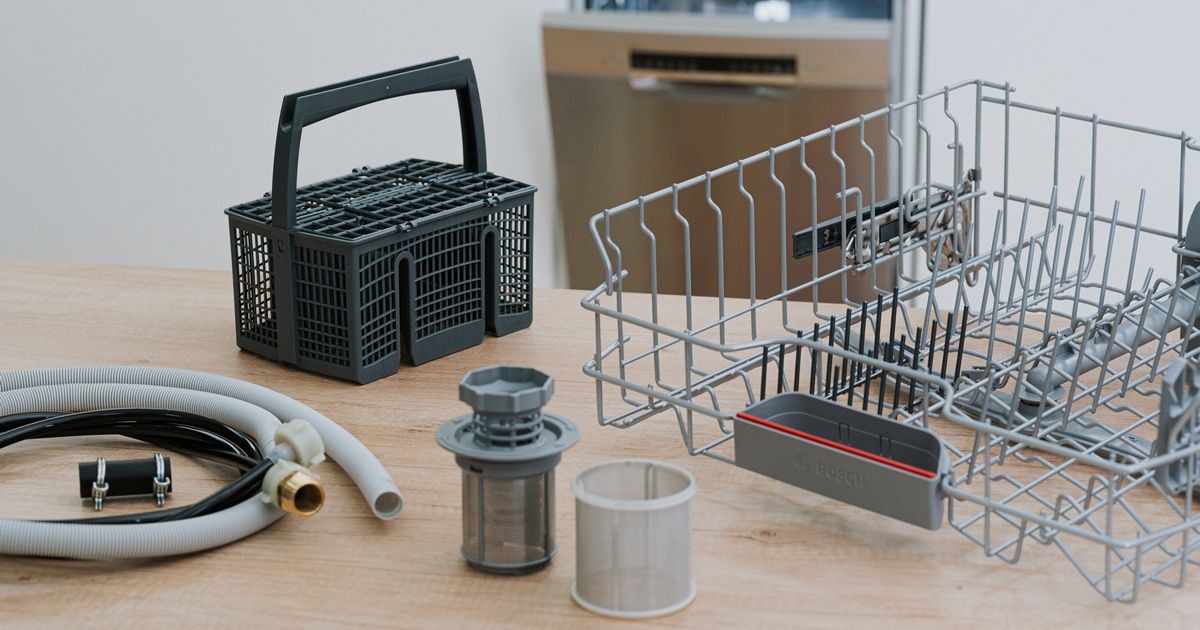Introduction
Dishwashers have become indispensable appliances in modern kitchens, saving time and effort when it comes to cleaning dishes. However, understanding the components of a dishwasher goes beyond simply knowing how to load and start a cycle. By delving into the inner workings of this modern marvel, you can gain a deeper appreciation for its functionality and ensure its longevity.
The Main Tub: The Heart of the Dishwasher
At the heart of every dishwasher lies the main tub, a large compartment where dishes are placed for cleaning. Typically made of durable stainless steel or plastic, the main tub provides a sturdy and hygienic environment for the cleaning process. As the cycle progresses, the main tub becomes the stage for a series of intricate actions, from the powerful spray of water to the intense heat generated by the heating element.
Racks and Rack Supports: Organizing and Securing Dishes
Within the main tub, a system of racks and rack supports ensures that your dishes are organized and securely positioned for optimal cleaning. The upper rack, typically located at the top of the dishwasher, is designed for smaller items like plates, bowls, and cups. The lower rack, positioned at the bottom, accommodates larger dishes, pots, and pans. Adjustable rack supports allow for flexible placement, so you can customize the dishwasher’s interior to fit your specific needs. Proper rack loading is crucial for effective cleaning. Ensure that dishes are evenly spaced and not blocking the spray arms, allowing water and detergent to reach every surface.
Spray Arms: The Rotating Water Delivery System
The rotating spray arms are the unsung heroes of the dishwasher, tirelessly distributing water and detergent throughout the main tub during the wash and rinse cycles. These arms, typically located at the bottom and top of the dishwasher, rotate in a synchronized pattern, ensuring that every corner of the tub receives a thorough cleaning. To maintain optimal performance, it’s essential to keep the spray arms free of clogs and debris. Regular inspection and cleaning can prevent blockages and ensure that water is efficiently delivered to all areas of the dishwasher.
Heating Element: Heating the Water for Cleaning
The heating element plays a vital role in enhancing the dishwasher’s cleaning power. Located at the bottom of the dishwasher tub, this component generates heat that raises the water temperature to a specific level. This heated water not only effectively dissolves grease and grime but also activates the enzymes in dishwasher detergent, which are responsible for breaking down protein and starch stains. The type of heating element varies depending on the dishwasher model. Traditional coil-type elements are common, while newer models may feature solid-state elements that offer improved energy efficiency and durability.
Filtration System: Trapping Food Debris and Protecting the Dishwasher
The filtration system is the dishwasher’s unsung hero, working tirelessly behind the scenes to trap food debris and protect the appliance from damage. This system typically consists of a primary filter and a secondary filter. The primary filter, usually located at the bottom of the dishwasher, captures large food particles and debris. The secondary filter, often situated in a finer mesh, removes smaller particles that could potentially clog the pump. Regular cleaning of both filters is essential to maintain optimal dishwasher performance and prevent damage to the pump.
Float Switch: Preventing Overfilling
The float switch acts as a guardian angel, preventing the dishwasher from overflowing and causing water damage. This safety mechanism is a simple yet crucial component that detects the water level within the main tub. As the dishwasher fills, the float switch rises with the water level. Once the tub reaches a predetermined level, the float switch triggers a signal that shuts off the water supply, ensuring that the dishwasher does not overflow. The float switch is typically located at the bottom of the dishwasher tub, easily accessible for inspection and cleaning.
Water Inlet Valve: Controlling Water Flow
The water inlet valve is the gatekeeper of the dishwasher’s water supply, regulating the flow of water from the main water line into the appliance. This valve, controlled by the dishwasher’s control panel, opens and closes to provide the precise amount of water needed for each wash and rinse cycle. The water inlet valve plays a critical role in ensuring efficient water usage and preventing damage to the dishwasher’s plumbing system. It is typically connected to both the main water supply line and the dishwasher tub, allowing for controlled water flow during the cleaning process.
Drain Pump: Removing Dirty Water
Once the wash and rinse cycles are complete, the drain pump takes over, removing dirty water from the dishwasher tub. This powerful pump, located at the bottom of the dishwasher, expels the water through the drain hose, ensuring that the dishwasher is clean and ready for the next cycle. Regular maintenance of the drain pump is essential to prevent clogging and ensure optimal performance. By inspecting and cleaning the drain pump periodically, you can extend the lifespan of your dishwasher and maintain its ability to effectively remove dirty water.
Door Latch and Switch: Ensuring Safety and Functionality
The door latch and switch work in tandem to ensure the dishwasher operates safely and effectively. The door latch, a secure mechanism typically located on the front of the dishwasher door, keeps the door firmly shut during the cleaning cycle. This prevents accidental opening and potential scalding from hot water or leaks onto the kitchen floor. The door switch, integrated with the door latch, plays a crucial role in preventing the dishwasher from starting when the door is open. This safety feature ensures that the dishwasher only operates when it’s closed, preventing water waste and potential damage to the appliance.
Control Panel: Operating the Dishwasher
The control panel serves as the command center of your dishwasher, allowing you to select wash cycles, adjust settings, and monitor the cleaning process. This user-friendly interface typically features buttons for cycle selection, option controls, and a display screen. The buttons allow you to choose from various wash cycles, such as heavy-duty, normal, or delicate, depending on the type of dishes you are cleaning. Option controls may include settings for water temperature, rinse aid usage, and delayed start. The display screen provides valuable information such as the selected cycle, remaining time, and any error messages that may arise. A well-designed control panel should be intuitive and easy to navigate, allowing you to customize the dishwasher’s settings to fit your specific needs.
Additional Parts: Enhancing Dishwasher Functionality
While the core components discussed above form the foundation of a dishwasher’s operation, there are several additional parts that contribute to its overall functionality and performance.
-
Water softener: In areas with hard water, a water softener can be a valuable addition. Hard water can leave mineral deposits on dishes and reduce the effectiveness of dishwasher detergent. A water softener counteracts the effects of hard water, preventing these issues and ensuring optimal cleaning performance.
-
Rinse aid dispenser: A rinse aid dispenser releases a rinse aid during the final rinse cycle. This rinse aid promotes water sheet formation on dishes, allowing them to dry more evenly and preventing water spots.
-
Vent system: The vent system allows steam and moisture to escape from the dishwasher after each cycle. This helps prevent condensation buildup within the dishwasher, which could lead to mold growth or unpleasant odors.

Conclusion
Understanding the various parts of a dishwasher goes beyond simply knowing how to load and operate it. By familiarizing yourself with the key components and their functions, you can gain a deeper appreciation for this modern marvel. From the powerful spray arms to the efficient filtration system, each part plays a vital role in ensuring a clean and efficient dishwashing experience. Regularly maintaining these components through cleaning and inspection can extend the lifespan of your dishwasher and keep it operating at its peak performance. So next time you load your dishwasher, take a moment to appreciate the intricate teamwork happening behind the scenes, ensuring sparkling clean dishes with every cycle.



